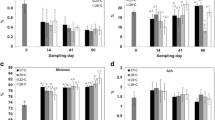Abstract
Four artificial, dry feeds and two diets consisting of natural, live food were evaluated for use as starter diets in the intensive rearing of European grayling (Thymallus thymallus). Long-term effects of the different diets were also studied. The investigation was divided into two parts: a 14 day starter period and the subsequent 115 days, during which the long-term effects were studied. Diets differed between the different treatment groups during the initial 2 weeks, whereafter all fish were offered a single diet. At the end of the starter period, significant differences in weight (p<0.001) were obtained between natural (control) feed groups and three of the artificial feed groups. The highest growth rate (9.6% day−1), and length increase (9 mm) as well as the lowest mortality rate (6.0%) were obtained with one of the artificial diets. Growth rate, length increase and mortality of grayling in the other diet groups varied from 3.6 to 7.7% day−1, 5 to 7 mm and 7.0 to 9.1%, respectively. The switchover to a different dry diet resulted in an increase in mean daily mortality for all groups previously fed a dry diet. For the fish previously fed live food the mortality rate remained about the same. Groups of fish growing slowly during one period seemed to compensate for their initially low growth by increasing their growth rates during the next period. The highest mean daily mortality for all groups during the experiment was observed during the period with the highest water temperature. It was concluded that European grayling can be intensively reared during the start-feeding phase on artificial as well as natural diets, and that artificial dry diets can be used exclusively throughout the first summer.
Similar content being viewed by others
References
Austreng, E., Storebakken, T. and Åsgård, T. (1987) Growth rate estimates for cultured Atlantic salmon and rainbow trout.Aquaculture 60, 157–160.
Bergot, P., Charlon, N. and Durante, H. (1986) The effect of compound diets feeding on growth and survival of coregonid larvae.Archiv für Hydrobiologie Beiheft, Ergebnisse der Limnologie 22, 265–272.
Carlstein, M. (1991) Biology and rearing of the European grayling (Thymallus thymallus).Introductory research essay no. 3. Swedish University of Agricultural Sciences, Department of Aquaculture. S-901 83 Umeå, Sweden. 25 pp.
Carlstein, M., Jansson, E., Ljungberg, O. and Svensson, K.M. (1990) Ulcerative disease of grayling (Thymallus thymallus L.) infected withAeromonas salmonicida var.achromogenes. International scientific conference; Bacterial diseases of fish, 26–29th June, University of Stirling, Scotland.
Carmie, H. and Jonard, L. (1988) Starting of grayling (Thymallus thymallus L.) larvae and production of estival juveniles exclusively using dry food.Bulletin Français de la Pêche et de la Pisciculture 311, 103–112.
Dabrowski, K. and Culver, D. (1991) The physiology of larval fish. Digestive tract and formulation of starter diets.Aquaculture magazine (March/April) 49–58.
Dabrowski, K., Charlon, N. Bergot, P. and Kaushik, S. (1984) Rearing of coregonid (Coregonus schinzi palea Cuv. et Val.) larvae using dry and live food. 1. Preliminary data.Aquaculture 41, 11–20.
Jungwirth, M. and Winkler, H. (1984) The temperature dependence of embryonic development of grayling (Thymallus thymallus), Danube salmon (Hucho hucho), Arctic char (Salvelinus alpinus) and brown trout (Salmo trutta fario).Aquaculture 38, 315–327.
Kazakov, R.V. (1981) The effect of the size of Atlantic salmon,Salmo salar L., eggs on embryos and alevins.Journal of Fish Biology 19, 353–360.
Kindschi, G.A. and Barrows, F.T. (1990) Diets for the intensive culture of Arctic grayling in Montana.The Progressive Fish-Culturist 52, 88–91.
Luczynski, M., Zaporowski, R.R. and Golonka, J.S. (1986) Rearing of European grayling,Thymallus thymallus L., larvae using dry and live food.Aquaculture and Fisheries Management 17, 275–280.
Mähr, K., Grabner, M., Hofer, R. and Moser, H. (1983) Histological and physiological development of the stomach inCoregonus sp.Archiv für Hydrobiologie 98, 344–353.
Ocvirk, J. and Vovk, J. (1986) The role of live zooplankton in the artificial rearing of the grayling (Thymallus thymallus L.).Ichthyos 3, 8–12.
Stroband, H.W.J. and Dabrowski, K.R. (1979) Morphological and physiological aspects of the digestive system and feeding in fresh-water fish larvae.Nutrition des Poissons (edited by Fontaine, M.). CERNA: Paris. pp. 335–376.
Tabachek, J.-O.L. (1988) The effect of feed particle size on the growth and feed efficiency of Arctic charr (Salvelinus alpinus (L.)).Aquaculture 71, 319–330.
Vijverberg, J. and Frank, Th.H. (1976) The chemical composition and energy contents of copepods and cladocerans in relation to their size.Freshwater Biology 6, 333–345.
Vovk, J. (1984) Dietary problems with zooplankton in fry breeding of grayling (Thymallus thymallus L.).Ichthyos 1, 2–6.
Wankowski, J.W.J. and Thorpe, J.E. (1979) The role of food particle size in the growth of juvenile Atlantic salmon (Salmo salar L.).Journal of Fish Biology 14, 351–370.
Wilkinson, L. (1990)SYSTAT: The System for Statistics. SYSTAT, Inc.: Evanston, IL.
Author information
Authors and Affiliations
Rights and permissions
About this article
Cite this article
Carlstein, M. Natural food and artificial, dry starter diets: effects on growth and survival in intensively reared European grayling. Aquacult Int 1, 112–123 (1993). https://doi.org/10.1007/BF00692615
Issue Date:
DOI: https://doi.org/10.1007/BF00692615




